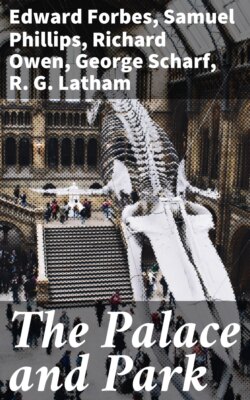Читать книгу The Palace and Park - Edward Winslow Forbes - Страница 19
COURT OF MONUMENTS OF ART.
ОглавлениеWe enter this Court (which is formed in one angle of the Great Transept with the Nave), as with the other Courts, from the Nave. The first objects that attract our notice are some beautiful statues of the Italian school, amongst which will be found many of Canova’s, several beautiful works by Richard Wyatt, and some from the chisel of Gibson. The statues at the garden end of the Court are mostly French. Some of the most conspicuous objects however in the Court are the very interesting crosses of the early Irish Church, and the richly sculptured bronze column from Hildesheim Cathedral in Germany, a fine example of the Byzantine period. Also a very interesting cross, from Pocklington, in Yorkshire—a fine example of the monumental art of the latter part of the 15th century. This specimen has been liberally presented by Samuel Leigh Sotheby, Esq.
Beyond these are monuments of the Gothic period, amongst which are conspicuous the Cantilupe shrine from Hereford Cathedral, and the effigy of Edward III., from Westminster; the central tombs, of Bishop Wakeman, from Tewkesbury, and of Bishop Bridport, from Salisbury (the last-named being that to the left).
The tomb of Henry VII., an interesting example of the Italian Renaissance style in England, at an early period of its introduction, and the fine bronze monument of Cardinal Zeno from Venice, occupy the further end; and the equestrian statue of Gattamelata, by Donatello, forms a conspicuous feature in this portion of the Court, where also is a fine bust of Cosmo de’ Medici, by Benvenuto Cellini. Under the gallery at the further end are two fine equestrian groups in bronze of Castor and Pollux, by San Giorgio of Milan. The originals stand in that beautiful city. Here also, in a corresponding position to the statue of Gattamelata, but nearer towards the nave, is the superb statue of Colleone. In the glass cases on the side next the Transept may be seen a most interesting collection of casts from ivory carvings, from the 2nd to the 15th century. These have been published by the Arundel Society.[19]
[19] The Arundel Society has been formed by a number of gentlemen, lovers of the Fine Arts, for the laudable purpose of publishing such works as, however valuable in themselves, are not likely by an extensive sale to repay a publisher; its means for this purpose being provided by such annual subscriptions as it may secure.
For minute and interesting information respecting the monuments, and all the statues on this side of the Palace, the visitor is referred to the Handbooks of the Mediæval and Italian Courts (by Messrs. M. D. Wyatt and J. B. Waring), where they are fully described.
Crossing the great transept to the west, we proceed towards the south end of the building, and, keeping to the right-hand, commence our pilgrimage through the Industrial Courts. The first that we arrive at is
